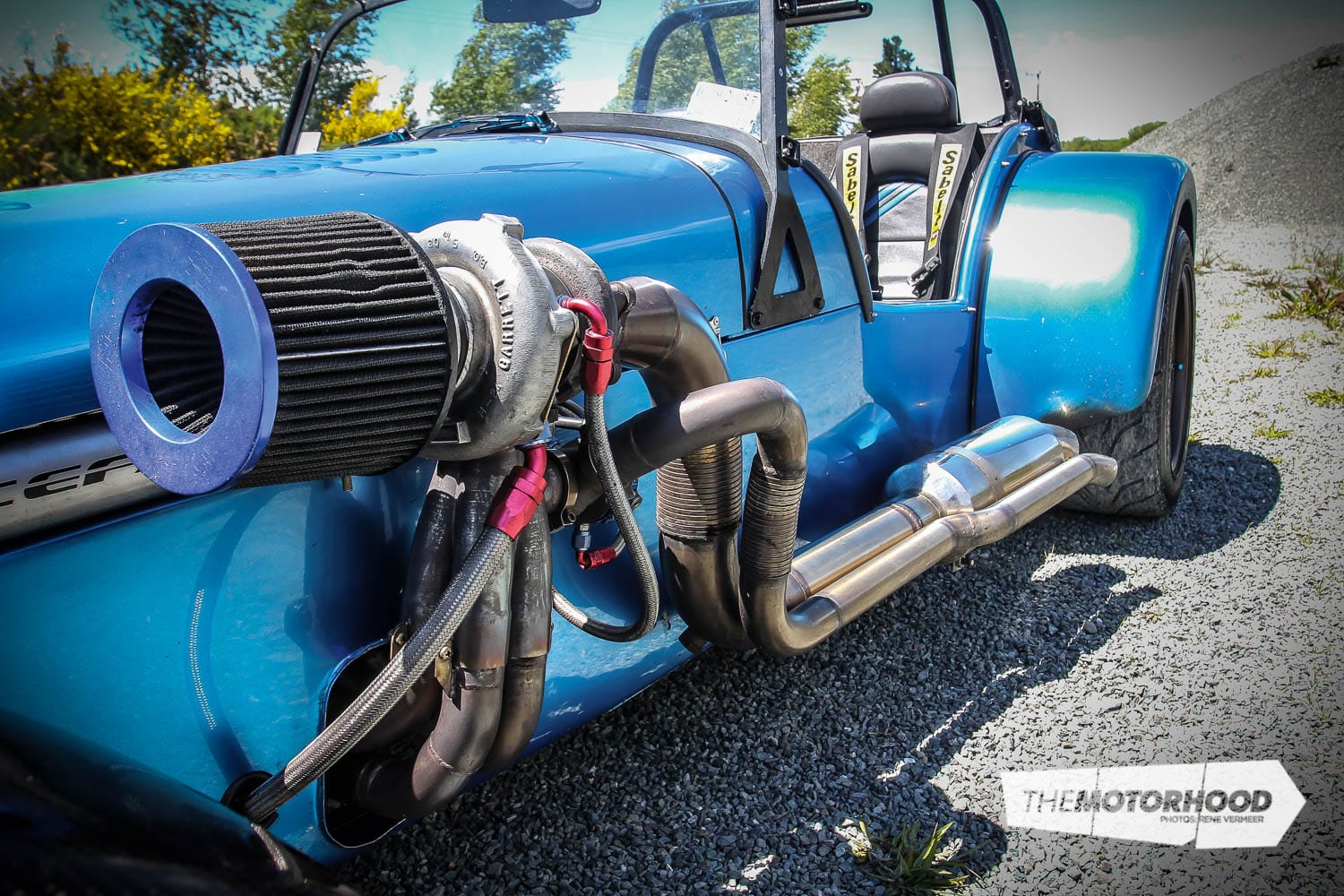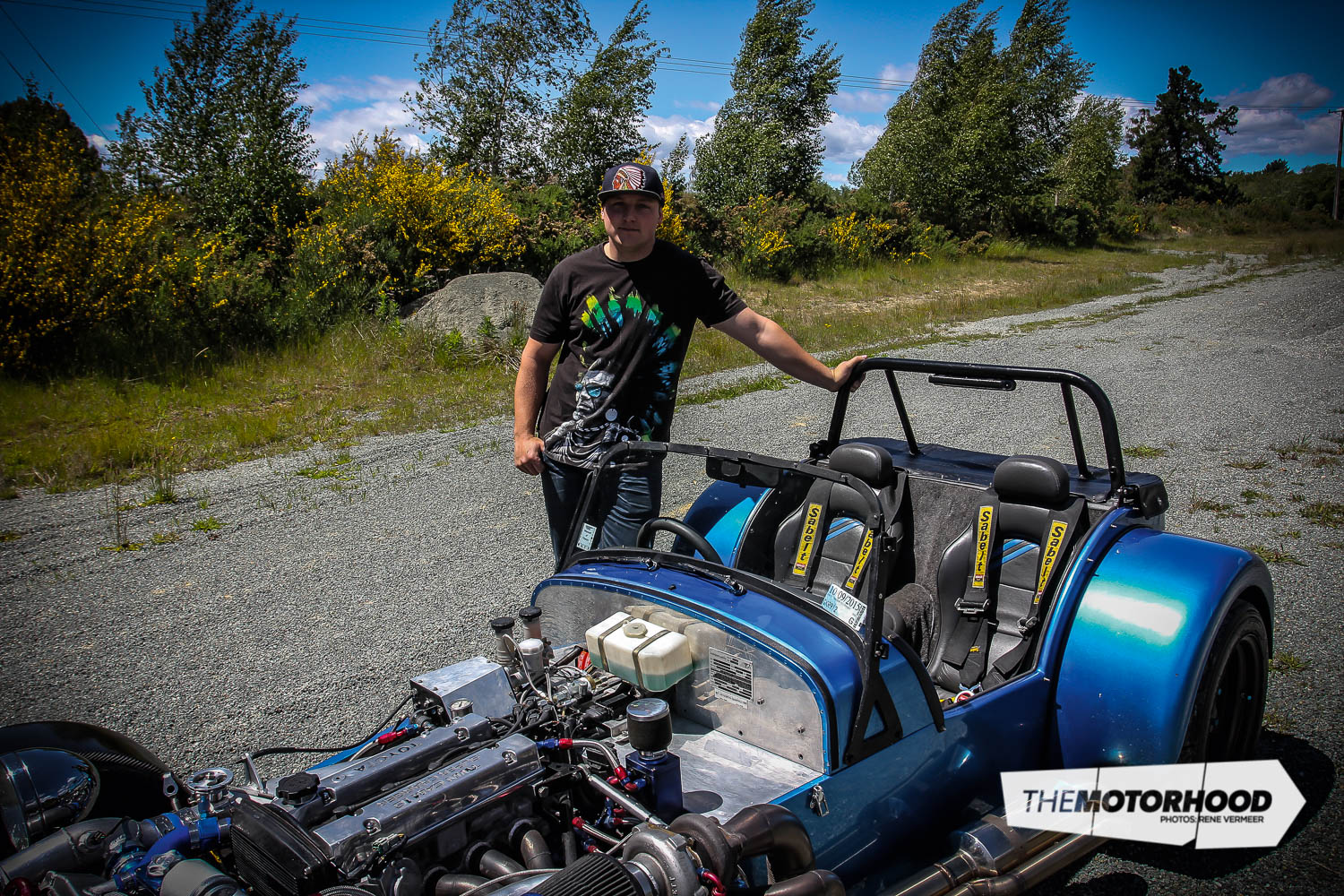data-animation-override>
“Never before has a Fraser 7 been covered in NZ Performance Car magazine. It looks as though we have been missing out!”
What makes something like this Fraser 7 so fast? It’s not one particular thing that makes it quick, as it might be with most cars. It’s not an abundance of power, nor is it the lightweight body or trick driveline — it’s a well-thought-out combination of all three, resulting in a reliable, fun, speed demon. But how did devoted Evo nut, Kane Thomas, end up with a two-seater Fraser 7? Well, his previous car — a Mitsubishi Evo V with 238kW at the wheels — kept breaking, and Kane spent more time under it than inside it.

As time is precious when he’s on New Zealand shores, as he is out at sea for months at a time on a factory trawler, a change needed to be made.
“After owning the Evo V for a few years, I changed seven clutches, two gearboxes, two engines and two transfer cases, as I liked to race it hard, but every time I did it seemed like I was rewarded with a week underneath it.”
Kane continued, “When I was at work, watching Top Gear, they featured a Caterham R500 Superlight that absolutely smashed their power leaderboard, and notched one up above the million-pound Bugatti — I took notice. When I got home I jumped online and found a car for sale up in Auckland for a good price, so after a quick phone call me and good friend, Drew Tuisamoa, jumped on a plane up to Auckland and drove it back home.”

At this stage the Fraser 7 just had a metallic-blue paint job, a 4AGZE engine and a T50 gearbox, none of which were responsible for keeping occupants cosy. The lack of heater and creature comforts aside, what the Fraser 7 Kane had just purchased did do, was go extremely fast.
At around 127kW (170hp) at the wheels, the supercharged 4AGZE was performing just as well as his gearbox-smashing 238kW Evo V. As he’s not one to leave things alone, Kane had already planned his future build on that trip home — before he’d even bought the car — along with jokes of a rat rod–inspired turbocharger set-up hanging out the side of the engine compartment.
“The idea grew on me, so I started talking to the best in the business down here, RaceFAB and NZEFI, about what I could achieve with this motor. After these discussions, I found out how awesome these little 1600cc motors are,” Kane explained.

With the decision to go turbo now certain, research needed to be done into what turbo would be best suited to the 1600cc set-up. Kane didn’t want much turbo lag, yet something that could keep up in the top end when mated to Toyota’s high-flowing 4AGZE head.
The team at Turbocare in Christchurch had just the recipe, a Garrett T28 turbo off a larger-capacity Silvia S14 SR20DET, but with an HKS compressor wheel and larger compressor housing, built to handle and flow 20psi-plus of boost.

Before heading off to sea for another three-month stint, Kane dropped the Fraser off to RaceFAB, to complete all its custom fabrication and install the newly built turbocharger.
The turbo sits up high, fed by the freshest of air channelled directly onto the turbo-mounted pod filter, something which was a must in the design brief. The exhaust gasses exit out of the five-bolt exhaust housing and into the three-inch stainless steel system, which exits out of the stainless dumpy exhaust, right next to the passenger entrance.
Boost control is taken care of with the Link ECU and NZEFI boost solenoid, but also the TiAL 38mm water-cooled external wastegate, which directs emissions out of a 40mm stainless-steel pipe which mimics the exhaust-system route.

On the intake side, RaceFAB fabricated a one-off intake plenum, with silicone joiners linking the plenum to the intake runners on the head, which allows for easy removal without having to change the intake gasket.
The compressed air is cooled via the custom RaceFAB intercooler and then makes its way into the plenum through the large 70mm throttle body. The result of all of this well thought out, well-executed conversion was a solid 225kW (302hp) at the wheels on 21psi of boost with 95-octane fuel. For racetrack duties, an E30 ethanol brew was mixed up and netted a staggering 261kW (351hp) at the wheels on 24psi of boost.

“When I got home, I was stoked with the new power of the car and all of the tidy custom work that had been done by RaceFAB and NZEFI,” Kane said. “After a few months of driving, the tired old T50 gearbox that was in the car failed under the new-found power, so I decided to go all-in with a good-quality gearbox. I researched many gearbox options, but only one stood out that would actually fit in the tunnel of my car. I decided to go with the Quaife sequential, which to me has been the make or break with this car.”

The T50 gearbox was well suited to the Fraser when the engine was only putting out 126kW, as the close ratios meant that it always felt punchy, but with the turbo hanging off the side and a power figure that has nearly doubled, traction was now a serious issue.
“First gear was utterly hopeless, with serious wheelspin, and second gear wasn’t much better. In third gear you would finally get some drive,” Kane said.
Scott Tristram, owner of Fraser cars, convinced Kane to go with a taller first gear, as there was no point in having numerous gears that just wheelspun. Top speed in first gear is now 92kph, and the remaining gears are spread 25kph apart, with a top speed of 232kph in sixth gear. “I actually took the car drag racing with the T50 gearbox, and my best time was 13 seconds flat, with Toyo R888 tyres and a damp track.

I haven’t actually made any more power since then, just changed to a better clutch, the new gearbox, and some Hoosier drag radials, and ran the 10.9-second pass,” Kane explained. With the Quaife sequential installed times dropped dramatically, all the way down to 10.9 seconds, but as we found out at the V 4&Rotary Nationals South Island Champs, this was the limit of the custom-built race driveshaft.
During the launch of the 10.9-second pass, Kane’s Fraser was still suffering from plenty of wheelspin, so on the next run, he decided to drop the tyre pressures further. Kane was sitting on the line, launch control in full effect with boost sitting at 20psi, ready for the light to go green. The clutch was dropped and a 1.4-second 60-foot time was achieved, but then all hell broke loose. Shortly after launching, the cabin turned into a war zone, with the driveshaft fighting its way through the transmission tunnel and finally ripping through, tearing Kane’s harness off and battering his leg.

The two driveshaft hoops contained the brawling driveshaft, and the reason it looked so nasty is the universal joints didn’t fail, so the torque of the engine kept twisting it, turning it into what Kane likes to call the ‘twisted noodle, or the Bluebird Twistie’.
This was a very unfortunate event, which ended his day’s racing, but fortunately, it did happen a week before he was off to sea for another three-month stint. With plenty of time aboard the trawler to ponder, Kane says he will plan the design of his new driveshaft set-up, transmission tunnel, fully forged motor, bigger wheels and bigger slicks — yeah, you get the idea, this wild Fraser isn’t finished yet.

002 Fraser Clubman, tubular spaceframe chassis No. 172 (Lotus 7 replica)
Heart
- Engine: Toyota 4AGE, 1600cc, four cylinder
- Block: AE101 4AGZE block, large winged sump with custom pickup and 5.0-litre capacity
- Head: Small port, ARP head studs
- Intake: K&N filter, 320x320x80mm custom RaceFAB bar and plate intercooler, 70mm throttle body, custom RaceFAB plenum
- Exhaust: RaceFAB three-inch stainless-steel exhaust, 40mm stainless-steel wastegate pipe, RaceFAB thick-wall stainless steel tuned-length manifold
- Turbo: Custom Turbocare-built Garrett T28 with HKS compressor wheel, larger compressor housing
- Wastegate: TiAL 38mm
- BOV: Turbosmart Race Port
- Fuel: Custom Fraser 40-litre tank, Facet lift pump, one-litre surge tank, Walbro 255 fuel pump, braided fuel lines, Tomei fuel-pressure regulator, Tomei fuel-pressure gauge, four Injector Dynamics 1000cc injectors
- Ignition: Wasted-spark coils
- ECU: Link G4 ECU tuned with dual fuel maps, NZEFI wiring harness
- Cooling: Alloy radiator with custom RaceFAB end tanks, external thermostat with alloy return lines, Toyota Surf in-car heater with 12V computer fan, 10-row oil cooler with braided lines, remote oil filter with drain catchment, custom radiator overflow catch tank, one-litre catch tank for head breather and gearbox breather
- Extra: Link ECU boost control with NZEFI boost solenoid, Link ECU launch control, custom alternator set-up
Drive
- Gearbox: Quaife six-speed sequential straight-cut dog box, custom gear set
- Clutch: Tilton twin-plate, cerametallic high-modulation disc
- Flywheel: Custom lightweight chromoly flywheel
- Diff: Nissan R200 shimmed by Fraser Cars, 4.1 ratio, custom alloy endplate to fit around de Dion bar
- Extra: Geartronics ECU (controls flat shifting and gear display), Quaife slave cylinder, custom high-strength half shafts, uprated CV joints, custom Beatty’s Driveshaft Company driveshaft
Support
- Struts: Custom Spax adjustable coilovers
- Extra: (F) Wide-track double A-arm, Fraser Cars 16mm sway bar (R) de Dion rear end, Nolathane bushes throughout
Exterior
- Paint: Metallic Toyota Electric RAV4 blue painted by Fraser Cars
- Enhancements: Completely hand-built by Fraser Cars
Shoes
- Wheels: 15×8-inch (-3) Work Meister CR01 three-piece
- Tyres: 205/50R15 Toyo R888 (street), 225/50R15 (drags, rear only)
Interior
- Seats: Fraser Cars leather seats
- Steering wheel GT Grant
- Instrumentation: Pricol classic-style boost, fuel, engine temp, oil pressure, speedo and rpm gauges
- ICE: Vietnam helicopter-pilot helmet with Skullcandy headphones retro-fitted inside
- Extra: Quaife sequential lever
Performance
- Power: 225kW (302hp) at the wheels on 21psi of boost and 95-octane fuel 261kW (351hp) at the wheels on 24psi of boost and E30 octane
- 0-400m: 10.945 at 130.05mph (209kph), 1.921 60ft
Driver profile
- Driver/owner: Kane Thomas
- Age: 28
- Location: Westport
- Occupation: Second mate on factory trawler
- Build time: 1.5 years
- Length of ownership: Two years
- Thanks: Scott and the team at Fraser Cars, also Phil, Walter and the guys at NZEFI, Rob at RaceFAB, Buller Hydraulics, Palmers Engineering, Diverse Engineering, Jim Rae Engineering, Michael Ryder, Drew, Saunders, Luke, and everyone else who lent a hand or helped out along the way with the build.
This article originally appeared in the February 2015 issue of NZ Performance Car. You can pick up a print copy or a digital copy of the mag now:

















